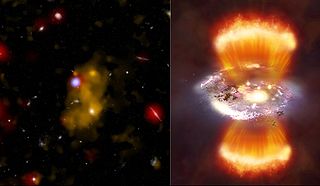
In the fields of Big Bang theory and cosmology, reionization is the process that caused electrically neutral atoms in the universe to reionize after the lapse of the "dark ages".

In astronomy, a Lyman-alpha blob (LAB) is a huge concentration of a gas emitting the Lyman-alpha emission line. LABs are some of the largest known individual objects in the Universe. Some of these gaseous structures are more than 400,000 light years across. So far they have only been found in the high-redshift universe because of the ultraviolet nature of the Lyman-alpha emission line. Since Earth's atmosphere is very effective at filtering out UV photons, the Lyman-alpha photons must be redshifted in order to be transmitted through the atmosphere.

A Lyman-alpha emitter (LAE) is a type of distant galaxy that emits Lyman-alpha radiation from neutral hydrogen.

Lyman-break galaxies are star-forming galaxies at high redshift that are selected using the differing appearance of the galaxy in several imaging filters due to the position of the Lyman limit. The technique has primarily been used to select galaxies at redshifts of z = 3–4 using ultraviolet and optical filters, but progress in ultraviolet astronomy and in infrared astronomy has allowed the use of this technique at lower and higher redshifts using ultraviolet and near-infrared filters.
TN J0924-2201 is the second most distant radio galaxy known to date. It was discovered by Wil van Breugel in 1999.

Tololo 1247-232 is a small galaxy at a distance of 652 million light-years. It is situated in the southern equatorial constellation of Hydra. Visually, Tol 1247 appears to be an irregular or possibly a barred spiral galaxy. Tol 1247 is named after the surveys that were carried at the Cerro Tololo Inter-American Observatory (CTIO), the first of which was in 1976. It is one of nine galaxies in the local universe known to emit Lyman continuum photons.

NGC 708 is an elliptical galaxy located 240 million light-years away in the constellation Andromeda and was discovered by astronomer William Herschel on September 21, 1786. It is classified as a cD galaxy and is the brightest member of Abell 262. NGC 708 is a weak FR I radio galaxy and is also classified as a type 2 Seyfert galaxy.

An extended emission-line region (EELR) is a giant interstellar cloud ionized by the radiation of an active galactic nucleus (AGN) inside a galaxy or photons produced by the shocks associated with the radio jets. An EELR can appear as a resolved cloud in relative nearby galaxies and as narrow emission lines in more distant galaxies.
4C +48.48 is a radio galaxy located in the constellation Cygnus. At the redshift of 2.343, it is one of the most distant galaxies ever seen, since light has taken at least 11 billion light-years to reach Earth.

UM 287 known as PHL 868 and LBQS 0049+0045, is a quasar located in the Cetus constellation. Its redshift is 2.267134 estimating the object to be located 10.9 billion light-years away from Earth.
TXS 1545-234 known as NVSS J154817-233701, is a radio galaxy located in the constellation Scorpius. It has a redshift of 2.755.

QSO J0100-2708 is a quasar located in the constellation Sculptor. With a redshift of 3.520000, the object is located 11.5 billion light-years away from Earth and contains a flat-spectrum radio source found brighter compared to S4.8 GHz=65 mJy.

MRC 0406-244 also known as TN J0408-2418, is a radio galaxy producing an astrophysical jet, located in the constellation of Eridanus. At its redshift of 2.44, it is roughly ten billion light years from Earth.

4C +72.26 known as NAME TX J1908+7220, is a radio galaxy located in the constellation Draco. At the redshift of 3.53, the galaxy is located roughly 11.5 billion light-years from Earth.
PKS 0529-549 known as MRC 0529-549 and PKS B0529-549, is a radio galaxy located in the constellation Pictor. At the redshift of 2.57, the object is located nearly 10.8 billion light-years away from Earth.

4C +41.17 is a radio galaxy located in the constellation Auriga. With the redshift of 3.79, it is located nearly 11.7 billion light-years from Earth. At the time of its discovery in 1988, it was one of the most distant galaxies ever seen.

4C +26.42 is an elliptical galaxy located in the constellation of Boötes. It has a redshift of 0.063, estimating the galaxy to be located 863 million light-years from Earth. It has an active galactic nucleus and is the brightest cluster galaxy (BCG) in Abell 1795, an X-ray luminous rich cluster (LX 1045 ergs s-1), with an estimated cooling-flow rate of 300 M yr-1.













